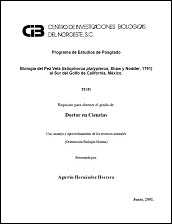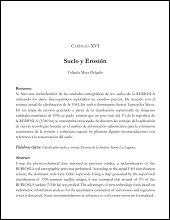Selección temporal y espacial de hábitat por la zorra del desierto (Vulpes macrotis devia), en las Planicies de Magdalena, B. C. S., México
Resumen
"La zorra del desierto (V. macrotis devia, Nelson y Goldman, 1909), es una especie que se encuentra incluida en la NOM-059-ECOL-2001 bajo la categoría de amenazada, sus requerimientos de hábitat (suelo, vegetación, alimentación etc.), pueden llegar a ser muy específicos por lo que los cambios en su hábitat la hace susceptible a extinción. En México se carece de información sobre esta especie, por lo que el presente estudio, tiene la finalidad de determinar la distribución y abundancia así como determinar las características (bióticas y abióticas) que permiten la selección del hábitat, tanto espacial como temporal de la zorra del desierto (V. macrotis) en los Llanos de la Yrais B.C.S. México. Objetivo General: Identificar los factores que determinan la selección del hábitat temporal y espacial de la zorra Vulpes macrotis devia, en los Llanos de Yrais (Planicies de Magdalena), B.C.S. México. Objetivos específicos: 1) Caracterizar el hábitat que selecciona de V. macrotis devia, en los Llanos de Yrais 2) Determinar la distribución y abundancia de Vulpes macrotis devia, en la región de los Llanos de Yrais 3) Determinar los hábitos alimentarios a lo largo de un año de Vulpes macrotis devia, en los Llanos de Yrais.4) Determinar la disponibilidad de las principales presas para Vulpes macrotis devia, en los Llanos de Yrais. Material y Métodos. La caracterización hábitat de V. macrotis se llevó a cabo a través de un Sistema de Información Geográfica (SIG), determinando a través de este el uso y selección de su hábitat. Se realizaron censos nocturnos sobre dos transectos (22.5 y 11km) para determinar la abundancia, de las presas potenciales, así como de sus depredadores. Se buscaron madrigueras en un área aproximada de 1.2km2 en los sitios donde se observaron individuos de V. macrotis; A las madriguera encontradas se les tomo datos como estado, número, tamaño y orientación de cada una de las entradas, distancia entre ellas, vegetación asociada y muestras de suelo. Se colectaron excrementos para determinar la dieta, así como su variación a través del periodo de estudio. Se estimó la densidad de las presas potenciales (roedores), a través del método de captura-marcaje-recaptura observado su variación espacial y temporal. Resultados: Se determinó un total de once unidades de paisaje en el área de estudio, el análisis espacial de la vegetación determinó la presencia de cuatro comunidades vegetales, siendo la del matorral sarcocaule la que presentó una alta riqueza..." "The kit fox (V. macrotis devia, Nelson and Goldman, 1909), is a species that is included in the NOM-059-ECOL-2001, under the category of threatened, their habitat requirements (soil, vegetation, feeding etc.), they could being very specific for changes in their habitat make it susceptible to extinction. In Mexico lacks information on this species, for that the present study, has the purpose to determine the distribution and abundance and determine the characteristics (biotic and abiotic) that allow selection of the habitat, so space as time of the kit fox (V. macrotis) in the Llanos de Yrais B.C.S. Mexico. General objective: Identify the factors that determine the selection of the temporary and space habitat of the kit fox (Vulpes macrotis devia), in the Llanos de Yrais (Plains of Magdalena), B.C.S. Mexico. Specific objectives: 1) Characterize the habitat that selects of V. macrotis devia, in the Llanos de Yrais 2) Determine the distribution and abundance of Vulpes macrotis devia, in the region of the Llanos de Yrais 3) Determine the alimentary habits along a year of Vulpes macrotis devia, in the Llanos de Yrais. 4) Determine the readiness of the main preys for Vulpes macrotis devia, in the Llanos de Yrais. Material and Methods: Habitat of V. macrotis was characterized through a System of Geographical Information (SIG); likewise with this it was analyzed and determined use and selection of its habitat. They were made in night censuses on two transects (22.5 and 11km); determine the abundance, of potential preys, as well as of their predators. Burrows were looked for in an approximate area of 1.2km2 in places where an individual of V. macrotis has observed, on burrow they are taken such data as state, number, size and orientation of each one of entrances, distance among them, associate vegetation and soil. In case of exist excrements, these were collected and with them, diet was determined as well as the variation of this through the period of study. Inside of three quadrants it estimated the density of the potential preys (rodents) through the method of capture-mark-recapture observed their space variation and time. Results: A total of eleven landscape units were determined in the study area, space analysis of vegetation determines the presence of four vegetable communities, being that of sarcocaule scrub, that present a high richness of species..."
Colecciones
Ítems relacionados
Mostrando ítems relacionados por Título, autor o materia.
-
PROMOCIÓN DEL PERIFITON PARA EL CULTIVO DE CAMARÓN BLANCO: HACIA UNA ACUICULTURA ECOLÓGICA
DOMENICO VOLTOLINA LOBINA; JUAN MANUEL AUDELO NARANJO; MARIA DEL ROSARIO PACHECO MARGES -
Suelo y Erosión
YOLANDA LOURDES MAYA DELGADO


